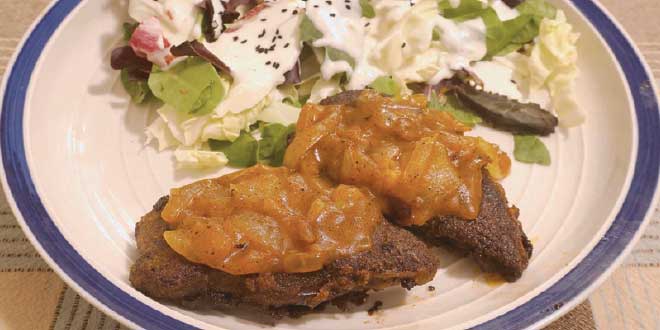Last season I harvested a fork-antlered mule deer. After gutting it, I carefully bagged the liver and heart. I immediately placed these on ice inside my cooler. Before harvesting my deer, I spoke to four other hunters who were skinning bucks hanging in trees. None of these hunters had kept the liver or heart from their deer. After having checked countless hunters in the field, as a conservation officer, I would say these four are in the majority of all hunters.
If you are a big-game hunter, I ask that you reconsider keeping your game’s heart and liver. A deer-sized liver or heart will feed two people and an elk sized liver or heart four or more. As with any game meat, if the heart or liver appear to be off colored, with cysts, or in otherwise poor condition they should be discarded with the rest of the gut pile.
When prepared correctly, these organs are delicious and contain very little to none of the iron taste they are known for. Not only do they taste good, they are good for you as well. The meat is lean and high in protein. Organ meat from wild animals are packed with healthy fats, B vitamins, minerals, high-quality amino acids, CoQ10 and vitamins A, D, E and K. Liver, in particular, is packed with iron, vitamin A, the B vitamins, choline, folic acid, purines and zinc. It is one of the most nutritionally valuable foods you can eat and that’s why predatory animals eat the liver first.
A heart is best eaten fresh. You can refrigerate it for up to a couple of days. When ready to cook, run cold water over the heart while pumping it. This will remove all the pooled blood from the ventricles and atriums. It is best to cut away and discard all fat, arteries, veins and blood vessels. Discard any parts of the heart damaged by the bullet or broadhead used to harvest the deer. The heart can be cut into ¼” to ½”cubes before cooking. There are a ton of big-game heart recipes you could find online. Just make sure you don’t overcook it because it will be as tough as leather.
You are looking to undercook it a little, to a nice medium doneness.
The liver can be frozen. I usually put it inside a freezer bag without rinsing, removing all the air, sealing and storing inside the freezer. It will keep up to a month, but I wouldn’t keep it frozen longer than that. A day before cooking, I will thaw it and let it soak under cold water in a bowl in the refrigerator for 24 hours. I change the water every eight hours, and then give it a final rinse before cutting into ½” slices. The water changes will remove the blood and keep the liver from tasting like iron. There are a number of different recipes to cook deer liver, or any other big-game liver, but my favorite way is the traditional preparation – fried with an onion and shallot gravy.
Fried deer liver with onion and shallot gravy recipe
Ingredients:
Deer liver
1.5 cups flour
2 tablespoons salt
2 tablespoons dry mustard
2 tablespoons garlic powder
1 tablespoon pepper
1 tablespoon lemon pepper
1 tablespoon paprika
1 shallot
1 large white onion
4 tablespoons clarified butter (ghee)
12 ounces chicken broth/stock
Instructions:
Rinse liver well and put in a large bowl. Cover with cold water. Refrigerate and soak for 24 hours. Change water every eight hours. Once liver has soaked, cut into ½ inch-thick slices. Heat five tablespoons of ghee over medium-high heat in a frying pan. Mix all the spices into the flour and dip the liver slices so they are completely covered. Place three or four slices into the hot butter and fry for four minutes per side or until golden brown. While the liver is frying, thinly slice the onion and shallot.
Once you have cooked all the liver, drain all but two tablespoons of the ghee and add the thinly sliced onion and shallot and cook six minutes or until they are slightly brown. Pour three tablespoons of the flour mixture over them and stir well. Cook until the flour begins to brown, another five minutes. Pour in 12 ounces of chicken broth/stock and bring to a boil. Once it begins to boil, reduce heat and stir while simmering until the gravy thickens. Plate the liver and bury under the onion and shallot gravy.
 New Mexico Wildlife magazine Conserving New Mexico's Wildlife for Future Generations
New Mexico Wildlife magazine Conserving New Mexico's Wildlife for Future Generations
